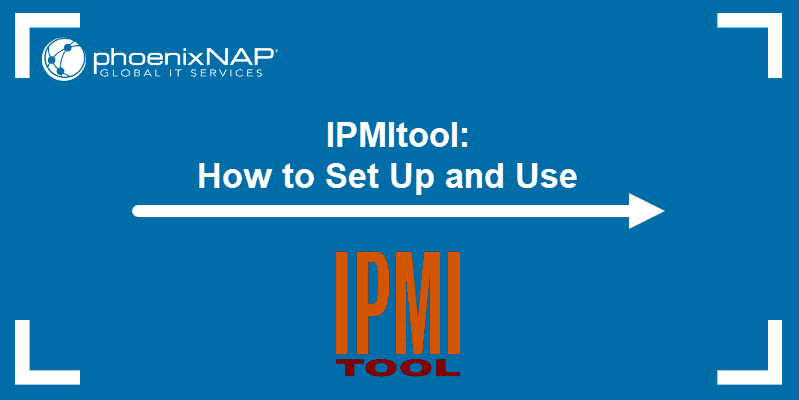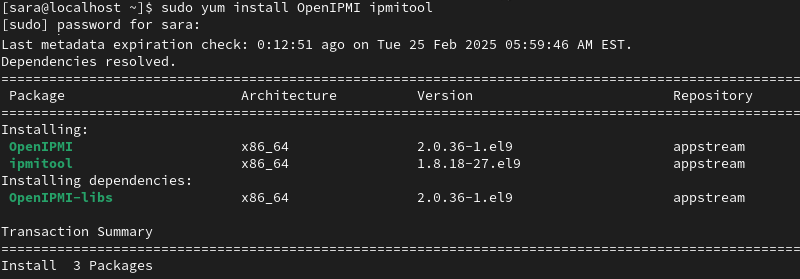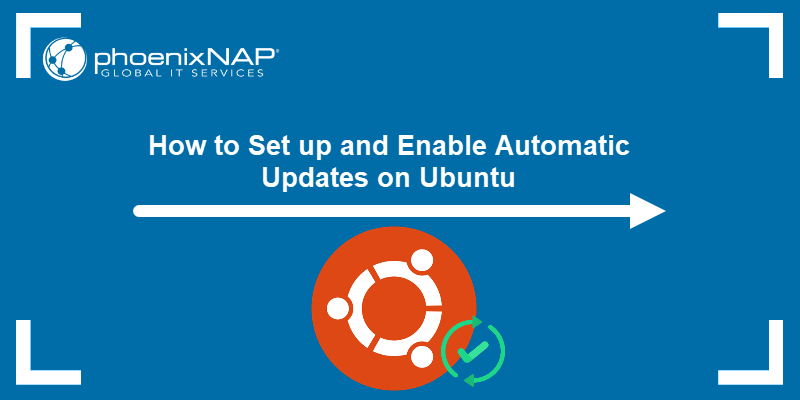IPMItool is a command-line utility used to access the features of an Intelligent Platform Management Interface (IPM), a system interface that enables management and monitoring of out-of-band computer systems. It allows you to control and configure IPMI-supported devices.
In this tutorial, you will learn how to install IPMItool on Linux-based systems, such as Ubuntu or Rocky Linux, and get started with basic IPMI commands.

Prerequisites
- A user account with sudo or root privileges.
- Access to the terminal.
- A Linux Ubuntu or Rocky Linux system.
Installing IPMItool on Ubuntu with apt
Ubuntu uses the apt package manager to handle software installation, making it easy to manage system packages and dependencies.
To install IPMItool on Ubuntu with apt, first update Ubuntu’s package repository:
sudo apt updateNext, install IPMItool on Ubuntu:
sudo apt install ipmitool
The process installs the IPMItool on your system.
Installing IPMItool on Rocky Linux with yum
Installing IPMItool with the yum package manager is a two-step process. Moreover, yum automatically handles dependencies, ensuring all necessary libraries and components are installed without manual intervention.
Take the steps below to install IPMItool with yum.
Step 1: Install IPMItool
To install IPMItool, first update system repositories with:
sudo yum update
Next, install IPMItool with the following:
sudo yum install OpenIPMI ipmitool
Wait for the installation to complete. The output indicates that OpenIPMItool and IPMItool have been installed.
Note: The IPMItool installation process for Rocky Linux should work for CentOS as well.
Step 2: Enable the Service
Once you have completed the installation, enable IPMItool access:
sudo systemctl enable ipmi
Next, start the IPMIitool service with the command:
sudo systemctl start ipmiThe command has no output if the process is successful.
IPMItool Commands Cheat Sheet
IPMItool includes commands for managing and monitoring out-of-band systems, which allow administrators to monitor, control, and troubleshoot hardware remotely. This section covers commands for interacting with the management controller, sensor outputs, chassis control, boot device modifications, and system event logs.
Therefore, understanding these commands helps efficiently manage server hardware, troubleshoot issues, and automate hardware-level tasks without requiring physical access to the system.
General IPMItool Commands
General commands provide fundamental operations that interact with the system's management controller and perform basic configurations.
The following table presents the most important general IPMItool commands:
| IPMItool Command | Description |
|---|---|
ipmitool help | Shows help info for IPMItool. |
ipmitool mc info | Checks the firmware version. |
ipmitool mc reset [warm/cold] | Resets the management controller. |
ipmitool fru print | Displays field-replaceable-unit details. |
Sensor Output IPMItool Commands
These commands retrieve real-time hardware sensor data, including temperature, fan speed, power supply status, and other critical system metrics.
They monitor system health, detect potential hardware failures, and ensure optimal performance in remote or data center environments.
The key sensor output commands are in the table below:
| Sensor Output Command | Description |
|---|---|
ipmitool sdr list | Lists all sensor names on the system. Each sensor is mapped to its corresponding sensor number. |
ipmitool sdr type list | Shows all sensor types on the system. |
ipmitool sdr type Fan | Lists all fan-type sensors on the system. |
ipmitool sdr type "Power Supply" | Presents all power supply type sensors on the system. |
ipmitool sdr type Temperature | Lists all temperature-type sensors on the system. |
Chassis Commands
These commands control and monitor the physical state of a system's chassis, including power management. Moreover, chassis commands are crucial because they remotely power servers on or off, reset them, and identify specific hardware units in large data centers without physical access.
The following table includes crucial chassis commands:
| Chassis IPMItoll Commands | Description |
|---|---|
ipmitool chassis status | Displays the current chassis status. |
ipmitool chassis identify [] | Turns on the front panel identify light. |
ipmitool [chassis] power soft | Performs a soft shutdown via ACPI. |
ipmitool [chassis] power cycle | Performs a combination of a hard power-off, 1-second wait, then power-on. |
ipmitool [chassis] power off | Performs a hard power-off. |
ipmitool [chassis] power on | Performs a hard power-on. |
ipmitool [chassis] power reset | Performs a hard reset. |
Modify Boot Device Commands
Modify boot device commands allow administrators to change the system’s boot order remotely. They are essential for remote troubleshooting, operating system (OS) installations, and system recovery, especially where physical access to the server is limited.
The table below presents some of these commands:
| Modify Boot Device | Description |
|---|---|
ipmitool chassis bootdev pxe | Modifies the boot order to boot PXE first. |
ipmitool chassis bootdev cdrom | Modifies the boot order to boot CD-ROm first. |
ipmitool chassis bootdev bios | Modifies the boot order to boot BIOS first. |
Logging IPMItool Commands
Logging commands manage the system event log (SEL), which records critical events and sensor data related to hardware and system status.
They monitor system health over time and maintain a detailed audit trail for system administrators in data centers or remote environments.
The key logging commands are in the following table:
| Logging IPMItools Commands | Description |
|---|---|
ipmitool sel info | Returns general information on system event logs. |
ipmitool sel list | Shows a list of system event logs. |
ipmitool sel elist | Displays a list of system event logs cross-referenced with sensor data logs. |
ipmitool sel get ID | Returns detailed information on a particular event log (use event ID to specify which log). |
ipmitool sel clear | Clear event logs. |
Conclusion
This article explained how to install IPMItool on your CenotOS or Ubuntu Linux system. Now, you can get started with IPMI and its command prompt using the commands above as a reference sheet.
Next, learn what system management is and how to use it to optimize an organization's IT infrastructure.


